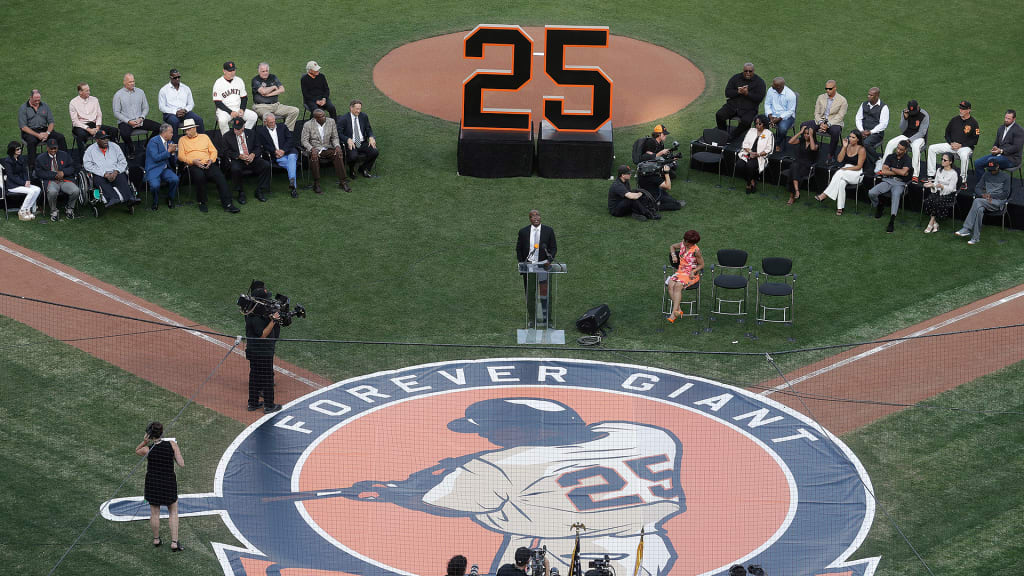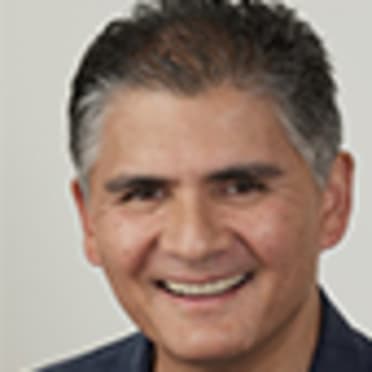
SAN FRANCISCO -- When Cooperstown calls, the Giants listen.
The Giants officially retire a player's number when he reaches the Hall of Fame. They've made two exceptions, placing left fielder Barry Bonds' No. 25 off-limits in 2018 and retiring Will Clark's No. 22 in 2022. Of course, Bonds possesses enough credentials to warrant such an honor, having ended his career after the 2007 season as baseball's all-time home run leader, and Clark was the driving force behind the Giants' revival in the late 1980s.
Except for a few relatively short gaps of time, the Giants have featured a nearly unbroken lineage of stars, as their list of retired uniform numbers indicates.
Christy Mathewson, P (no number)
Number retired: Aug. 17, 1986
Mathewson's 1900-16 stint with the Giants preceded the use of jersey numbers. Not that Mathewson needed a number to distinguish himself, anyway. The right-hander won 20 or more games 13 times and recorded at least 30 wins in four of those seasons, including three years in a row (1903-05). He won a career-high 37 games in 1908. Nicknamed the "Big Six" after a company of elite firefighters, Mathewson retired with multiple franchise records that still stand, including wins (372), complete games (434), shutouts (79), innings (4,779 2/3) and strikeouts (2,504). He's a member of the Hall of Fame's inaugural induction class and was named to the All-Century Team.
John McGraw, manager (no number)
Number retired: Aug. 17, 1986
McGraw piloted the Giants to 21 first- or second-place finishes in his 29 full seasons with the club, helping him compile a career 2,583-1,790 mark with the team. McGraw led the Giants to three World Series titles while winning 10 pennants in a highly competitive National League. Nicknamed the "Little Napoleon," McGraw managed numerous star players, including Mathewson, Rube Marquard, Bill Terry, Frankie Frisch and Freddie Lindstrom.
Bill Terry, 1B: No. 3
Number retired: April 5, 1983
Terry spent his entire 14-year playing career with the Giants, finishing among the top 13 in Most Valuable Player Award balloting four times. His .341 lifetime batting average reflected his consistency, as he hit .310 or higher in each of his last 10 seasons. Terry reached his zenith in 1930 when he batted .401. Following his playing career, Terry managed the Giants from 1932-41, guiding the team to three pennants and one World Series championship. He was elected to the Hall of Fame in 1954.
Mel Ott, OF: No. 4
Number retired: 1949
Ott was known for "stepping in the bucket," taking an exaggerated front leg kick before each swing. As has been the case with many great players, the ordinary fundamentals didn't apply to Ott, the first National Leaguer to pass the 500-home run plateau. The left-handed batter paced the NL in home runs six times, helping him make 11 consecutive All-Star teams (1934-44) and finish among the top 20 in league MVP balloting 13 times. Ott retired as the franchise leader in RBIs with 1,860. Elected to the Hall of Fame in 1951, Ott served as player-manager for the Giants from 1942-48, posting a 464-530 mark.
Carl Hubbell, P: No. 11
Number retired: 1944
Hubbell earned the nickname "The Meal Ticket" for his ability to feed the Giants' need for a solid effort in virtually every start. The slender left-hander spent his entire 16-year career with the Giants, finishing 253-154 while winning MVP awards in 1933 (23-12, 1.66 ERA) and '36 (26-6, 2.31). Hubbell earned undying fame for his screwball and his dominance of baseball's greatest hitters at the 1934 All-Star Game. In his second of nine selections to the Midsummer Classic, Hubbell struck out five future Hall of Famers in succession: Babe Ruth, Lou Gehrig, Jimmie Foxx, Al Simmons and Joe Cronin. The first National Leaguer to have his number retired, Hubbell was inducted into the Hall of Fame in 1947.
Monte Irvin, OF: No. 20
Number retired: June 26, 2010
Baseball's leaders thought so highly of Irvin that he, not Jackie Robinson, received serious consideration to be the African-American chosen to break the sport's color barrier. But Irvin, who served in the Army in World War II, didn't feel he was prepared to face Major League competition at the time. A star in the Negro Leagues with the Newark Eagles, Irvin made his big league debut with the Giants in 1949. He was essential to the Giants' remarkable comeback in '51, when they forced a playoff with the Dodgers after trailing by 13 games on Aug. 11. Irvin hit 24 homers and drove in a league-high 121 runs that year. Irvin was inducted into the Hall of Fame in '73.
Will Clark, 1B, No. 22
Number retired: July 2022
Clark became the 11th Giant to have his number retired on July 30. Selected with the second overall pick of the 1985 MLB Draft out of Mississippi State, Clark played for the Giants for eight seasons, earning five All-Star appearances and finishing in the top five in National League MVP voting four times. Known for his sweet left-handed swing, signature eye black and relentless intensity on the field, Clark’s arrival in 1986 played a major role in reviving a franchise that had lost 100 games the previous season.
Willie Mays, CF: No. 24
Number retired: 1972
The "Say Hey Kid" is widely acknowledged as the finest performer in history. He became the second player to reach 600 home runs, exceeded 100 runs scored in 12 consecutive seasons, won the Gold Glove Award in its first 12 years of existence and was the first to amass 300 home runs and 300 stolen bases. Mays twice won the NL MVP Award but easily could have doubled that total. He set numerous All-Star Game records while appearing in 24 Midsummer Classics, which itself set a standard shared by Hank Aaron and Stan Musial. Named a starting outfielder on the All-Century Team, Mays received 94.7 percent of the vote when he was elected to the Hall of Fame in 1978, the highest percentage since the first five players were enshrined in '36.
Barry Bonds, LF: No. 25
Number retired: Aug. 11, 2018
Bonds is unlike the others on this list by not being in the Hall of the Fame. He has one more chance to gain enshrinement through the Baseball Writers' Association of America vote. He received 61.8 percent of the vote in 2021, significantly short of the necessary 75 percent for induction. Except for allegations of the use of performance-enhancing drugs, there's no argument about Bonds' qualifications. He won seven NL MVP Awards during his 22-year career, including five with the Giants (1993; 2001-04). Given Bonds' 1.051 lifetime OPS and that all-time-high total of 762 homers, he essentially spent much of his big league tenure in a sustained hot streak.
Juan Marichal, P: No. 27
Number retired: 1975
Marichal's signature high leg kick made him distinctive, and his prodigious statistical totals proved his dominance. Marichal pitched a one-hit shutout against Philadelphia in his Major League debut on July 19, 1960, and he didn't stop there. The "Dominican Dandy" won 191 games during the 1960s, more than anyone during a decade that featured remarkable starting pitching. The right-hander exceeded 20 victories in six seasons, winning 25 in 1963 and '66 before totaling a career-high 26 in '68. He retired as the Giants' all-time leader during their San Francisco era (since '58) in wins (238), complete games (244), shutouts (52), innings (3,444) and strikeouts (2,281). He was inducted into the Hall of Fame in '83.
Orlando Cepeda, 1B: No. 30
Number retired: July 11, 1999
Cepeda won the NL Rookie of the Year Award in 1958, the Giants' inaugural season in San Francisco, and then he kept on hitting. He batted .308 during eight-plus seasons with San Francisco, compared to .284 through the rest of his 17-year career. He was a perennial All-Star in San Francisco from '59-64 and topped 30 homers in the final four years of that span. The Giants learned the hard way just how much of an impact Cepeda could make by bidding him farewell in a '66 trade for St. Louis lefty Ray Sadecki. One year later, Cepeda was the NL MVP and led the Cardinals to a World Series title. He was inducted into the Hall of Fame in '99.
Gaylord Perry, P: No. 36
Number retired: July 23, 2005
Perry has become synonymous with the spitball, an outlawed pitch that he never formally admitted using. He also deserves recognition for his longevity, which was illustrated by his 777 appearances, 314-265 record and 5,350 innings over 22 seasons. Perry pitched for eight teams but truly established himself with the Giants, his original club for whom he won at least 15 games each year from 1966-71. The right-hander ultimately became the first pitcher to win the Cy Young Award in both leagues, earning the honor in '74 with Cleveland and in '78 with San Diego. He was inducted into the Hall of Fame in '91.
Willie McCovey, 1B: No. 44
Number retired: Sept. 21, 1980
McCovey was widely considered baseball's most feared hitter in the late 1960s and early '70s. His 45 intentional walks in 1969 obliterated the previous standard of 33 set by Ted Williams in '57. Defensive shifts, which are common today, were unheard of during the reign of McCovey, who prompted opponents to employ three defenders between first and second base and add a fourth outfielder. McCovey frequently responded by hitting the ball beyond everybody. He retired in '80 with 521 career home runs, more than any NL left-handed batter until Barry Bonds came along. McCovey's 18 grand slams set another NL record, and his character led the Giants to create the Willie Mac Award, given annually to the team's most inspirational player.
Note: On April 15, 1997, the Giants joined every team in MLB in retiring No. 42 in honor of Jackie Robinson.
